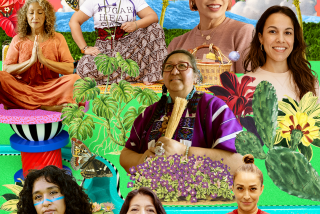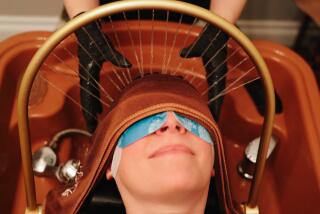Body Watch : Baby Bodywork : With whispering fingertips, therapists say they can heal chronic problems in little ones--from colic to irritability. It’s called craniosacral therapy and some say it’s the perfect therapy.
- Share via
Is it all right if I work on you?” the therapist asks, kneeling on the rug where her patient lies.
Cassie Roden cheerfully indicates it’s fine and Lynne Oyama begins their session.
“Now we’re going to check out your parietals,” the therapist explains, while reaching into the patient’s mouth. Cassie giggles and starts to mutter something. Instead she grabs a fist full of Oyama’s hair. You do that when you’re 5 1/2 months old.
Cassie is getting a treatment from Oyama, a nurse who practices craniosacral therapy on infants at the Chapman Family Center in Santa Monica.
Cranio what? If you’re scratching your head, you’re getting warm.
One of the more subtle healing techniques to come down the alternative pike, craniosacral therapy--according to its proponents--is the perfect bodywork for babies.
There’s no snap, crack or pop. No massaging of muscles or jerking of bones. Here, therapists work on the hydraulic-like fluid involved with the nervous system, often by just cradling the head for minutes on end. Their touch is never heavier than the weight of a nickel, but it can be worth a lot more.
Take the case of 18-month-old Leanna Dresher.
“Right after her birth I could see an indentation from the forceps near her left temple, and that was the side she got chronic ear infections on,” says mother Pam Dresher, a Westside physical therapist. “After Lynne saw her three or four times, she never got another one.”
Beyond clearing up ear infections, craniosacral therapy has also been shown to improve a wide range of infant problems, including irritability, sucking difficulties, constipation, colic.
The American Academy of Pediatrics has no official policy on craniosacral therapy and more likely than not, your own baby’s doctor has never heard of it. As for those who have? “It’s a pretty harmless intervention,” says Dr. Jay Gordon, a Santa Monica pediatrician. “If a child is out of alignment--through a big fall or difficult birth--my common sense tells me that there could be some benefit to gently realigning them.”
Many medical experts agree that craniosacral therapy is so mild that its biggest danger--at $85-$100 a session--may be to your purse.
But that’s where Oyama is stepping in.
She has just started a weekly clinic at the Chapman Center where parents can bring their infants in for craniosacral evaluation sessions--free.
“If babies start out balanced, at least they’ll have a fighting chance,” says Oyama, who also works full time as a nurse at Santa Monica Hospital in the newborn nursery and postpartum departments. “This is not a replacement for medical care,” she stresses. “It’s complementary.” (In accordance with hospital protocol, she does not practice craniosacral therapy there.)
*
Not to be confused with cranio osteopathy, chiropractic craniopathy or sacro-occipital technique, which aim primarily to move bones, craniosacral therapy is less intrusive, nudging the patient’s body to make its own corrections. With whispering fingertips, therapists feel for abnormalities in the craniosacral pulse--completely separate from the heartbeat or breathing rate--that belongs to the fluid and membranes surrounding the brain and spinal cord. The bones of this craniosacral system--the skull, face and mouth (cranium) down to the tailbone (sacrum)--are used merely as handles to gently unwind the membranes and restore the fluid’s natural flow.
Why would newborns, fresh off the drawing board, need any internal unwinding? Childbirth is, indeed, one of the biggest traumas to their little bodies.
“C-sections are extremely traumatic because the baby goes from liquid to air very quickly like a diver coming up too fast,” says Oyama. Precipitous births are also stressful: “Normally, the mother’s contractions help the bones of the cranium compress slowly. Here they just jam together.”
Whether Cassie’s digestive difficulties--due to a condition called gastroesophageal reflux, which has her spitting up 30 to 40 times a day--have anything to do with the way she was born, no one knows for sure. But at Michigan State University in the late ‘70s, osteopathic physician, Dr. John Upledger, found a correlation between various delivery complications, craniosacral kinks and abnormalities--physical and behavioral problems--in 203 children.
Upledger is the name usually mentioned in the same breath as craniosacral therapy. He is the man responsible over the last 20 years for developing the technique--a refinement of cranial osteopathy, which has been around since the 1930s. He is also founder of the Upledger Institute in Palm Beach Gardens, Florida, where thousands of craniosacral therapists, including Oyama, have trained.
“This therapy has not been investigated in terms which the scientific community would understand or accept,” he is quick to say. “I can tell you what happens; not why.”
One of the clearest whats is that in about half of all hyperactive children, the head is slightly jammed forward on the neck. Upledger speculates that this position, possibly caused by being pulled out too hard or fast at birth, puts the brain under a slightly increased hydraulic pressure that makes it uncomfortable and hard to concentrate. When this is the problem, he says, craniosacral therapy can be quite effective.
Oyama, 46, discovered craniosacral therapy eight years ago. “I grew up on a small farm in Hawaii where the rhythms of life and changes in season are very subtle,” she says, explaining why this form of bodywork hit home.
Her interest in babies grew out of treating adults and thinking, “if only I’d gotten to them earlier.” But it would take 10 Geiger-counter fingertips and lots of experience to put that thought into practice: If a grown person’s craniosacral pulse is as hard to detect as the line below the one you can read on the E-chart, a newborn’s rhythm is several lines below that.
While working on her digital chops for several years, Oyama earned her nursing degree so she could learn more about infants in a medical setting.
“She has a way of tuning into and respecting the innate wisdom of an infant and she’s got such a light touch,” says Laura Paris, a Westside homeopath and doctor of Oriental medicine, who has referred many of her younger patients to Oyama--including her own son, Hunter.
“Most people feel children don’t remember their births,” Oyama says. “But more and more research shows they do remember . . . at least on a cellular level. . . . The first few weeks of life you can’t hold a baby too much.”


